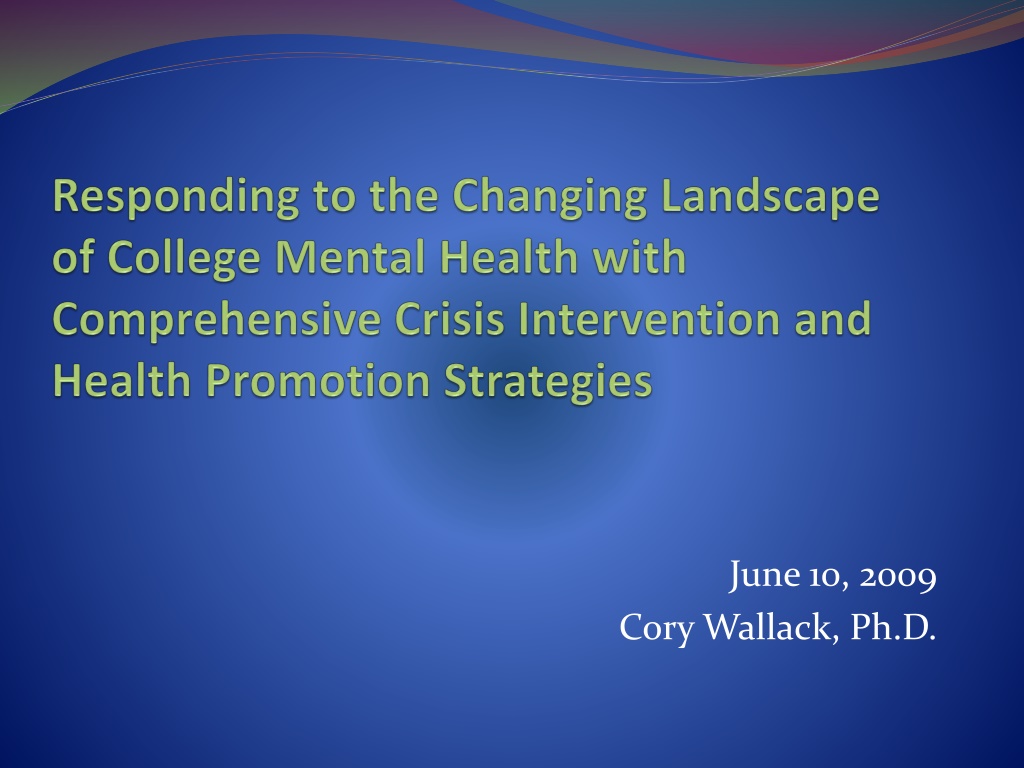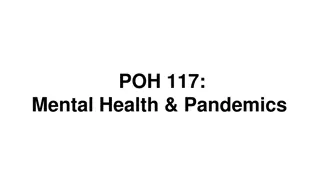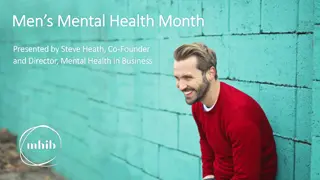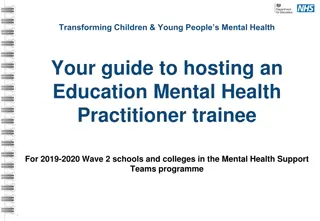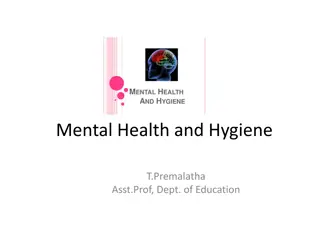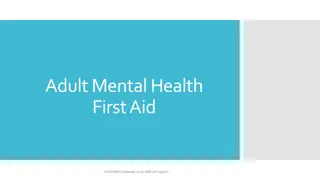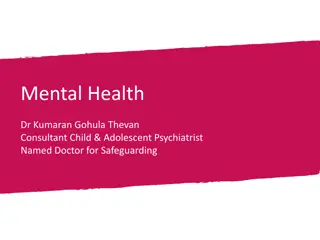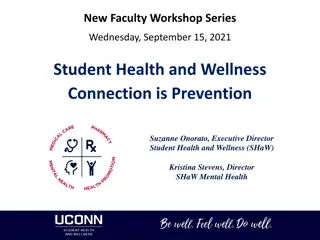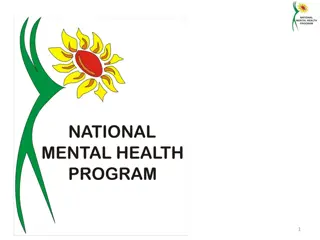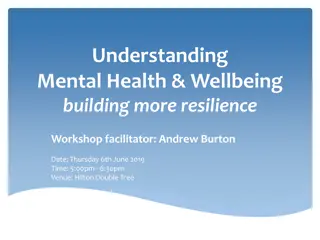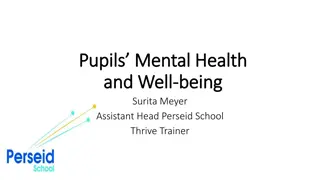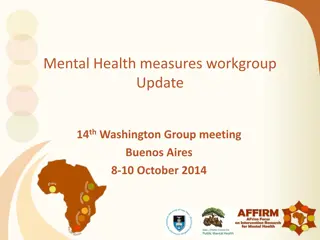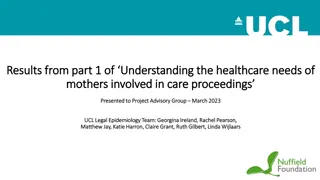Understanding the Evolving Landscape of College Mental Health Services
Exploring the changing landscape of college mental health services, this presentation delves into the challenges faced in crisis intervention along with readiness issues before implementing strategies. A case discussion highlights the stress and demands on counseling centers, emphasizing the importance of addressing high burnout levels and overwhelming workloads to provide effective support.
- College Mental Health
- Crisis Intervention
- Counseling Centers
- Stress Management
- Mental Health Services
Download Presentation

Please find below an Image/Link to download the presentation.
The content on the website is provided AS IS for your information and personal use only. It may not be sold, licensed, or shared on other websites without obtaining consent from the author. Download presentation by click this link. If you encounter any issues during the download, it is possible that the publisher has removed the file from their server.
E N D
Presentation Transcript
June 10, 2009 Cory Wallack, Ph.D.
Todays Goals Review the changing landscape of college mental health and the impact on provision of crisis intervention services Explore both philosophical and practical concerns as they relate to effective crisis intervention services Discuss readiness issues and questions that should be addressed before implementing crisis intervention strategies, programs, and protocols Present an overview of Syracuse University s comprehensive crisis intervention and health promotion model
A Brief Case Discussion to Get Us Started
At intake a client reports: Frequently feeling overwhelmed because of multiple tasks, responsibilities, and demands to balance Difficulty prioritizing tasks, difficulty multi-tasking, difficulty balancing various responsibilities Barely keeping her head above water, always on the run High performance expectations Failure is not an option External and internal expectations of being able to do it all Sense that multiple others are watching and waiting to see if she fails or succeeds Although feeling pressured and overwhelmed, she is fearful and/or unable to voice concerns to others for fear of how she may be perceived or judged
A Few Questions and Reflections to Keep Us Going
Back to Our Case Discussion: Life in a Counseling Center Fast paced, high demand, high stress work Increasing intensity of client presenting problems coupled with increasing numbers of students seeking our services On-going struggle with balancing individual clients, crisis response, group clients, outreach/education, paperwork, etc. Burnout level is high, feeling stressed and overwhelmed is common To know where we are going, we have to know how we got here
The Changing Landscape of College Mental Health High profile legal and media cases MIT, Ferrum College, George Washington, NYU Increased emphasis on studies reporting high rates of hopelessness, depression, suicidal ideation 2005 National College Health Assessment 2006 Counseling Center Consortium Data Counseling Center Directors' reports Garrett Lee Smith Act and JED Foundation Virginia Tech and Northern Illinois
The Changing Landscape of SU s Counseling Center Services Percent Change 2007 Statistics 2008 Statistics 7% 3.7% 4546 Client Contacts 1523 Students Receiving Services 304 Emergency Assessments 216 Psychiatry Clients 18.2% of clients report suicidal thoughts 4871 Client Contacts 1579 Students Receiving Services 440 Emergency Assessments 234 Psychiatry Clients 23.6% of clients report suicidal thoughts 45% 8.3% 5.4%
The Changing Mental Health Picture of Our Students Students coming to campus with more significant mental health problems Students described as: Facing overwhelming demand Lacking coping skills Lacking distress tolerance Connected-disconnected generation Impact of global events Soaring tuition rates Helicopter parents
Responding to the Changing Landscape Counseling Centers at maximum client capacity and lacking resources to meet the demand, yet students expecting to be seen immediately e.g., increased crisis intervention Increased demand on colleges and universities to demonstrate comprehensive crisis intervention, risk assessment, and suicide prevention programs Increased employment of mandated assessments, mandated counseling, and forced leave of absences Increased employment of behavioral consultation teams and case managers
Crisis Intervention Broadly Defined Primary Prevention and Mental Health Promotion Coping skills, stress management, distress tolerance, relationship skills Stopping the crises before it starts Secondary & Tertiary Intervention Identifying and intervening with distressed students Postvention and follow-up Policies and Procedures Mandated assessments, leave of absence, etc Ideally, your campus should address all of the above
Where to Begin? SPRC/JED Comprehensive Model
Where to Begin? The Importance of Sound Data Know the national and local data on student mental health Generally speaking, campuses are safe places A caution about how we reinforce the culture of fear What is the unique nature of your campus climate regarding mental health? Consider a needs assessment Survey students and parents Survey faculty and staff
Where to Begin: Assessing Your Campus Culture Some questions to consider: To what extent does fear impact your system? To what extent does the language of liability drive decision making? What is the system s level of distress tolerance? Are decisions being made rationally? Does your system tend to be reactionary or proactive? Does the system have a balance of prevention and intervention Does your system recognize its limits, resources, etc and create an appropriate model for your students, or is there a parallel process at play? To effectively move forward, we have to thoroughly understand the culture we are working in and address it first
Philosophical Thoughts on the Role of Counseling Centers College counseling centers can and should be the leaders in developing mental health protocols, policies, procedures, programs At times, mental health professionals appear to have lost their voice Too often we defer to attorneys and administrators who may not be expert in the field of mental health The vast majority of counseling center staff aren t qualified to conduct threat assessment Counseling center staff can t do it alone Public health model is a vital approach
Where to Begin? The Importance of Theory What are your driving beliefs, theories, and passions about crisis response? Joiner Baumeister Well Theory Dark Nights of the Soul Essentially a mission, vision, and values statement Sound theory allows you to connect all crisis intervention protocols back to central driving themes and values
So You Have a Theory and Know The Culture: Now What? The Example of Gatekeeper Training
Readiness Issues: Preparing the system Gaining institutional support for the training Are relevant parties aware of the training? Will they be trained as well? Think top-down and bottom-up Review relevant policies/procedures/protocols for the various departments you will be working with Mandated assessments Does your campus have a plan for after hours emergencies Remember, our students live in a different time zone than most of us!
Readiness Issues: Counseling Center Concerns Is the counseling center staff trained and prepared to effectively respond to students in crisis? Crisis intervention is a specific skill set Threat assessment and suicide assessment Is the counseling center staff prepared for consultation role? Is there sufficient availability of emergency appointments and walk-in assessment? Do you have sufficient availability of psychiatric services If you don t have sufficient resources to address the above, do you have referral resources in place?
Readiness Issues: Assessing Your Resources Driving question: How can you most effectively and efficiently utilize existing resources? Time How much do you have? How much do you ideally need? People Who are your gatekeepers? Who are your trainers? What involvement do you want faculty to have? What is the role of students? Money Can you secure grants or partner with other offices to enhance cost efficiency?
Readiness Issues: Marketing Your Efforts How can you market the training Press releases School newspaper Mailings Suicide prevention Kick-off event Handouts to give participants Reference cards Certificate of completion
Readiness Issues: Evaluating Your Program What goals are you trying to achieve? Need to be realistic Need a timeline Need to be measurable How to measure training success Increased referrals Base-line data is ESSENTIAL Increased knowledge and skills What tools are there available to use?
Primary Prevention Students Stress management Relationship building skills Communication skills Conflict Resolution Parents Trainings frequently target identifying warning signs We have an opportunity to help parents better support students Helicopter parents will attend workshops if invited!
Secondary and Tertiary Prevention Individually targeted efforts: Behavioral consultation committees Triage issues Case managers Broader targeted efforts Depression/Anxiety screening days On-line screenings Gatekeeper training
Postvention and Follow-up Factors to consider following student death Do you have a formal crises response team? Do you have structured processes for conducting debriefings? Are staff that conduct debriefings properly trained? Do you have pre-established relationship with appropriate media outlets? How is information communicated across campus? What happens days, weeks, months after the event?
Defining Our Philosophy and Strategy Our beliefs, guiding theories, and passion Impact of loneliness, isolation, lack of coping skills Contributions of Joiner and Baumeister Answering these questions lead to a strategy . Connection Distress tolerance Acceptance
Comprehensive Crisis Intervention Initiatives MH awareness and services utilization survey M.H. policies/procedures which sensitively respond to high risk behaviors (e.g. MLOA, mandated evaluations) Enhanced clinical services increased emergency and psychiatric services; AMSR training for CC staff Gatekeeper training for students, staff, & faculty- Campus Connect, Distressed Student Module Life Skills Development MBSR program Facilitating Help-seeking behaviors--campus wide media campaign/ Sustainability Plan
Creation of Our Broad Goals Foster a greater sense of individual and community connection Positively influence campus culture by creating a greater tolerance for and acceptance of emotional distress Promote life enhancing skills Destigmatize mental health problems and increase help- seeking behaviors
Creation of Specific and Measurable Goals Campus Connect Train ORL, Health Services, Academic Counselors Measure increased knowledge, skill, efficacy MBSR Train students life skills Measure perceived stress, physical symptoms, coping skills Counseling Center awareness and utilization Pre and Post initiative assessments
We Had a Strategy and Goals... But, How to Resource It? Perfect timing for securing the SAMHSA Suicide Prevention Grant Stayed true to our philosophy Comprehensive and preventative Allowed for innovation and creativity Grant allowed us to fill in the gaps and create a unique, philosophically connected program Post-grant considered sustainability
The Program Has Been A Success But, How Do We Sustain it? Know, educate and involve key University players Give them language Bring them into your broad vision What s in it for them? Communicate your program s data results Tailor your data to each different audience Write a good white paper Outline the strategic plan succinctly and realistically go for the ask University Institutionalization Increased resources Cross campus mental health task force
New Pieces To be Added Behavioral consultation committee Parent/Family workshops More direct outreach and support for students through Office of Multicultural Affairs and International Student Services Integrated eating disorder treatment protocols Community liaison working more directly with community agencies
